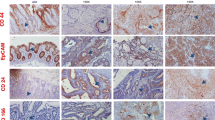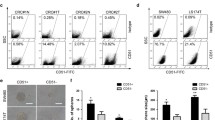Abstract
Stem-like cancer cells (SLCCs) are distinct cellular subpopulation in colon cancer that is essential for tumor maintenance. Previous studies indicated that SLCCs accounted for only a minor subset in a given cancer model. However, we found that SLCCs frequency varied among a panel of colon cancer cell lines, with HCT116 cells composed mainly of SLCCs, as demonstrated by colonosphere forming capability and CD133 expression. Indeed, flow cytometric analysis revealed more than 60% HCT116 cells co-expressed the putative SLCCs markers CD133 and CD44. Compared with non-CD133+CD44+ cells, FACS sorted CD133+CD44+ cells were undifferentiated, endowed with extensive self-renewal and epithelial lineage differentiation capacity in vitro. CD133+CD44+ exhibited enhanced tumorigeneicity in NOD/SCID mice. One thousand CD133+CD44+ cells initiated xenograft tumors efficiently (3/6) while 1 × 105 non-CD133+CD44+ cells could only form palpable nodule with much slower growth rate (1/6). More interestingly, long-term cultured self-renewing CD133+CD44+ cells enriched CD133+CD44high subset, which expressed epithelial to mesenchymal transition marker, were more invasive in vitro and responsible solely for liver metastasis in vivo. In conclusion, these data demonstrated for the first time that CD133+CD44+ SLCCs were highly enriched in HCT116 cells and that metastatic SLCCs resided exclusively in a CD133+CD44high subpopulation.







Similar content being viewed by others
References
Jemal A, Siegel R, Xu J et al (2010) Cancer statistics, 2010. CA Cancer J Clin 60:277–300
Fearon ER, Vogelstein B (1990) A genetic model for colorectal tumorigenesis. Cell 61(5):759–767
Preston SL, Wong WM, Chan AO et al (2003) Bottom-up histogenesis of colorectal adenomas: origin in the monocryptal adenoma and initial expansion by crypt fission. Cancer Res 63(13):3819–3825
Barker N, Ridgway RA, van Es JH et al (2009) Crypt stem cells as the cells-of-origin of intestinal cancer. Nature 457(7229):608–611
Zhu L, Gibson P, Currle DS et al (2009) Prominin 1 marks intestinal stem cells that are susceptible to neoplastic transformation. Nature 457(7229):603–607
Ricci-Vitiani L, Lombardi DG, Pilozzi E et al (2007) Identification and expansion of human colon-cancer-initiating cells. Nature 445(7123):111–115
O’Brien CA, Pollett A, Gallinger S et al (2007) A human colon cancer cell capable of initiating tumour growth in immunodeficient mice. Nature 445(7123):106–110
Fang DD, Kim YJ, Lee CN et al (2010) Expansion of CD133(+) colon cancer cultures retaining stem cell properties to enable cancer stem cell target discovery. Br J Cancer 102(8):1265–1275
Li CY, Li BX, Liang Y et al (2009) Higher percentage of CD133+ cells is associated with poor prognosis in colon carcinoma patients with stage IIIB. J Transl Med 7:56
Horst D, Kriegl L, Engel J et al (2009) Prognostic significance of the cancer stem cell markers CD133, CD44, and CD166 in colorectal cancer. Cancer Invest 27(8):844–850
Shmelkov S, Butler J, Hooper A et al (2008) CD133 expression is not restricted to stem cells, and both CD133+ and CD133− metastatic colon cancer cells initiate tumors. J Clin Investig 118(6):2111–2120
Dittfeld C, Dietrich A, Peickert S et al (2009) CD133 expression is not selective for tumor-initiating or radioresistant cell populations in the CRC cell lines HCT-116. Radiother Oncol 92(3):353–361
Chu P, Clanton DJ, Snipas TS et al (2009) Characterization of a subpopulation of colon cancer cells with stem cell-like properties. Int J Cancer 124(6):1312–1321
Dalerba P, Dylla SJ, Park IK et al (2007) Phenotypic characterization of human colorectal cancer stem cells. Proc Natl Acad Sci USA 104(24):10158–10163
Du L, Wang H, He L et al (2008) CD44 is of functional importance for colorectal cancer stem cells. Clin Cancer Res 14(21):6751–6760
Ponti D, Costa A, Zaffaroni N et al (2005) Isolation and in vitro propagation of tumorigenic breast cancer cells with stem/progenitor cell properties. Cancer Res 65(13):5506–5511
Lee J, Kotliarova S, Kotliarov Y et al (2006) Tumor stem cells derived from glioblastomas cultured in bFGF and EGF more closely mirror the phenotype and genotype of primary tumors than do serum-cultured cell lines. Cancer Cell 9(5):391–403
Ieta K, Tanaka F, Haraguchi N et al (2008) Biological and genetic characteristics of tumor-initiating cells in colon cancer. Ann Surg Oncol 15(2):638–648
Dean M, Fojo T, Bates S (2005) Tumour stem cells and drug resistance. Nat Rev Cancer 5(4):275–284
Sack MJ, Roberts SA (1997) Cytokeratins 20 and 7 in the differential diagnosis of metastatic carcinoma in cytologic specimens. Diagn Cytopathol 16(2):132–136
Mani SA, Guo W, Liao MJ et al (2008) The epithelial-mesenchymal transition generates cells with properties of stem cells. Cell 133(4):704–715
Haraguchi N, Ohkuma M, Sakashita H et al (2008) CD133+CD44+ population efficiently enriches colon cancer initiating cells. Ann Surg Oncol 15(10):2927–2933
Kai K, Nagano O, Sugihara E et al (2009) Maintenance of HCT116 colon cancer cell line conforms to a stochastic model but not a cancer stem cell model. Cancer Sci 100(12):2275–2282
Stuelten CH, Mertins SD, Busch JI et al (2010) Complex display of putative tumor stem cell markers in the NCI60 tumor cell line panel. Stem Cells 28(4):649–660
Botchkina G, Zuniga E, Das M et al (2010) New-generation taxoid SB-T-1214 inhibits stem cell-related gene expression in 3D cancer spheroids induced by purified colon tumor-initiating cells. Mol Cancer 9(1):192
Yeung TM, Gandhi SC, Wilding JL et al (2010) Cancer stem cells from colorectal cancer-derived cell lines. Proc Natl Acad Sci USA 107(8):3722–3727
Zeppernick F, Ahmadi R, Campos B et al (2008) Stem cell marker CD133 affects clinical outcome in glioma patients. Clin Cancer Res 14(1):123–129
Rasheed ZA, Yang J, Wang Q et al (2010) Prognostic significance of tumorigenic cells with mesenchymal features in pancreatic adenocarcinoma. J Natl Cancer Inst 102(5):340–351
Zheng X, Shen G, Yang X et al (2007) Most C6 cells are cancer stem cells: evidence from clonal and population analyses. Cancer Res 67(8):3691–3697
Bexell D, Gunnarsson S, Siesjo P et al (2009) CD133+ and nestin+ tumor-initiating cells dominate in N29 and N32 experimental gliomas. Int J Cancer 125(1):15–22
Huang Q, Zhang Q-B, Dong J et al (2008) Glioma stem cells are more aggressive in recurrent tumors with malignant progression than in the primary tumor, and both can be maintained long-term in vitro. BMC Cancer 8(1):304
Xu X-L, Xing B-C, Han H-B et al (2010) The properties of tumor-initiating cells from a hepatocellular carcinoma patient’s primary and recurrent tumor. Carcinogenesis 31(2):167–174
Pece S, Tosoni D, Confalonieri S et al (2010) Biological and molecular heterogeneity of breast cancers correlates with their cancer stem cell content. Cell 140(1):62–73
Bacac M, Stamenkovic I (2008) Metastatic cancer cell. Annu Rev Pathol 3:221–247
Yang ZF, Ho DW, Ng MN et al (2008) Significance of CD90+ cancer stem cells in human liver cancer. Cancer Cell 13(2):153–166
Hermann PC, Huber SL, Herrler T et al (2007) Distinct populations of cancer stem cells determine tumor growth and metastatic activity in human pancreatic cancer. Cell Stem Cell 1(3):313–323
Pang R, Law WL, Chu ACY et al (2010) A subpopulation of CD26+ cancer stem cells with metastatic capacity in human colorectal cancer. Cell Stem Cell 6(6):603–615
Hope K, Jin L, Dick J (2004) Acute myeloid leukemia originates from a hierarchy of leukemic stem cell classes that differ in self-renewal capacity. Nat Immunol 5(7):738–743
Chen R, Nishimura M, Bumbaca S et al (2010) A hierarchy of self-renewing tumor-initiating cell types in glioblastoma. Cancer Cell 17(4):362–375
Acknowledgments
We thank Dr. Jia-si Bai (Central Laboratory, Southwest Hospital, Chongqing, China) for technical assistance in laser confocal scanning microscopy. This work was supported by the grants from the National Basic Research Program of China (973 Program, No 2010CB529403) and the Natural Science Foundation Project of CQ CSTC (No. CSTC2009BB5328).
Conflict of interest
We declared that no conflicts of interest should be disclosed.
Author information
Authors and Affiliations
Corresponding author
Additional information
Ke-li Chen and Feng Pan are contributed equally to this work.
Rights and permissions
About this article
Cite this article
Chen, Kl., Pan, F., Jiang, H. et al. Highly enriched CD133+CD44+ stem-like cells with CD133+CD44high metastatic subset in HCT116 colon cancer cells. Clin Exp Metastasis 28, 751–763 (2011). https://doi.org/10.1007/s10585-011-9407-7
Received:
Accepted:
Published:
Issue Date:
DOI: https://doi.org/10.1007/s10585-011-9407-7




